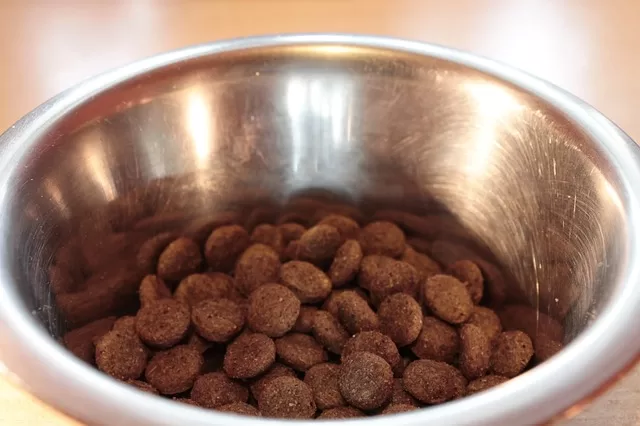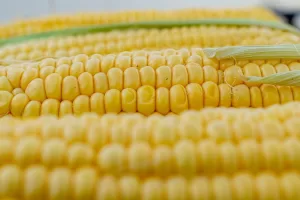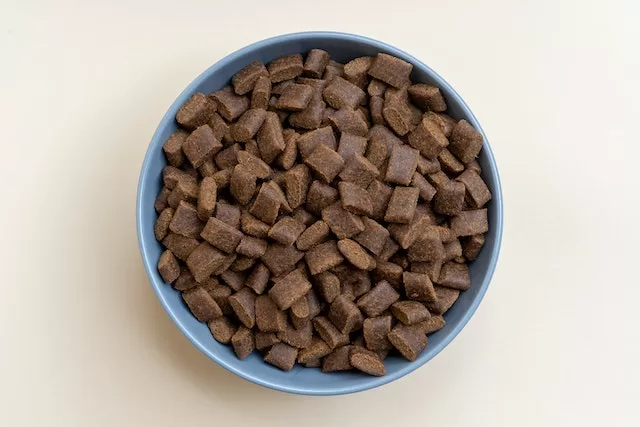This post contains affiliate links. See our Affiliate Disclosure Statement page for more details.
Table of Contents
Is Natural Dog Food Better Than Kibble?
The number of pet owners feeding their dogs natural dogs foods has steadily increased over the last decade. In fact, pet owners often want to feed their pets a similar type of diet to their own and since they are eating more natural foods they want the same for their pet.
So, we set out to answer the question, Is Natural Dog Food Better than Kibble? We uncovered 6 exclusive benefits that natural dog foods offer versus Kibble that can improve your pet’s diet & nutrition.
Is Natural Dog Food Better Than Kibble? 6 Exclusive Benefits
- High-quality ingredients
- Typically includes real meats (such as chicken, beef, or fish)
- Use whole grains, fruits, vegetables
- Utilize Beneficial Supplements
- Limited or no artificial additives
- Avoid or minimizes the use of artificial additives such as artificial flavors, colors, and preservatives
- Use natural ingredients are used to enhance flavor, appearance, and shelf life.
- No by-products or fillers
- Avoid using by-products (such as chicken by-product meal)
- Avoid fillers (such as corn, wheat, or soy) that provide little nutritional value
- Focus on using wholesome ingredients that contribute to a well-balanced diet for dogs
- No synthetic chemicals or hormones
- Strive to exclude synthetic chemicals, growth hormones, and antibiotics from their products
- Aim to provide a more natural and healthier option for dogs
- Transparency and sourcing
- Prioritize transparency by providing detailed information about their ingredients, sourcing practices, and manufacturing processes
- May use locally sourced or responsibly raised ingredients
- Minimal processing
- Typically minimally processed to retain the nutritional value of the ingredients
- This can include methods such as slow cooking, freeze-drying, or using gentle techniques to preserve the natural goodness of the ingredients
We will examine these in more detail but first want to provide information on the habits & practices of pet owners’ use of natural dog food based on consumer research and purchasing data.
For additional information on dog foods versus kibble read our articles
Wet vs. Dry: 5 Best Reasons Why Wet Dog Food Outshines Kibble in Health and Nutrition
For natural dog food try ONLY NATURAL PET RAW BLENDS CHICKEN AND POULTRY FEAST RAW GRAIN FREE DOG FOOD – 18 LB
Is Natural Dog Food Better than Kibble? Pet Owner Habits & Practices
As part of our research on the question. Is natural dog food better than kibble? we examined pet owner habits & practices and commercial purchases to see if there was an increased trend in the use of natural foods.
We uncovered some interesting data and statistics relating to the use of natural dog food by pets.

Image by Andreas Breitling from Pixabay
A large survey of 2,500 pet owners was conducted by BENEO, a large pet ingredient supplier to uncover pet owners beliefs regarding health & wellness products and ingredients.
This was a global study that included pet owners from Germany, UK, United States, China and Brazil.
The results were published in PetFood Industry.com, Tim Wall, February 14, 2020.
Mr. Wall reported the following results from the study.
- “81%, of pet owners worldwide ‘completely’ or ‘somewhat’ agreed with the statement that they want the same quality standards for their pets’ foods as their own.“
- “Labeling a pet food as “made with natural ingredients” influenced 52% of respondents’ likelihood of purchasing that product”.
- “The digestive health of their pet was reported as ‘extremely’ or ‘very’ important to 83% of pet survey respondents.”
Responses listed above are from the article 52% of pet owners influenced by natural ingredient claims, PetFood Industry.com, Tim Wall, February 2020.
Another article, Pet food purchasing habits and trends of U.S. pet owners, Pet Industry.com, Debbie Phillips-Donaldson, February 23, 2022, shared purchasing data and trends in the pet food market.
The article presented the following information
- “In 2020, slightly more dog owners, 41%, bought premium dog food than “basic/generic,” at 39%, according to the APPA survey.“
- “Other types of food purchasing that APPA surveyed included natural (19% for dog owners), Grain Free (14%) and organic 10%.“
Note that natural foods made up 20% of food purchased by dog owners.
Finally, in the study The Value-Added Dog Food Market: Do Dog Owners Prefer Natural or Organic Dog Foods? Journal of Agricultural Science, Simonsen, Faskeno, Lillywhite, 5/14,
A total of 661 dog owners were surveyed for this study. The study authors reported in their findings that
- “Respondents prefer dog food made with natural ingredients to dog foods made with conventional or organic ingredients.“
- “Although price was the most important attribute, ingredient source (e.g. natural, 75/25% organic/non-organic or 100/0% organic/non-organic) was more important than the other dog food attributes studied.”
Now let’s look at the benefits of Natural and begin to answer the question, Is Natural dog food better than Kibble?
Is Natural Dog Food Better Than Kibble? Benefits of Natural Food

Is Natural Dog Food Better Than Kibble – Benefits
High-Quality Ingredients
Natural dog foods tend to contain high-quality protein sources, fruits and vegetables, and healthy fats as compared to kibble that may use by-products and lower quality sources of protein
. The table below shows a comparison between Natural dog food and Kibble.
Table: Natural Dog Food Ingredients, Type, and Uses
| Ingredient | Source | Macronutrient | Reason for Use | Benefits |
| Chicken | Poultry meat | Protein | Animal protein source | Builds and repairs tissues, supports muscle development |
| Salmon | Fish | Protein, Omega-3 | Rich in essential fatty acids | Promotes healthy skin and coat, supports brain and joint health |
| Sweet Potato | Root vegetable | Carbohydrate | Grain-free carbohydrate source | Provides energy, rich in dietary fiber and antioxidants |
| Quinoa | Whole grain | Carbohydrate, Protein | Gluten-free carbohydrate and plant protein source | Rich in essential amino acids, vitamins, and minerals |
| Blueberries | Fruit | Carbohydrate, Antioxidants | Natural source of antioxidants | Supports immune system, promotes cellular health |
| Pumpkin | Vegetable | Fiber, Vitamin A | Natural source of dietary fiber | Aids digestion, supports healthy skin and eyesight |
| Spinach | Leafy green vegetable | Fiber, Vitamins | Nutrient-dense green vegetable | Rich in vitamins, minerals, and antioxidants |
| Flaxseed | Seed | Omega-3, Fiber | Source of essential fatty acids and dietary fiber | Supports healthy skin and coat, aids digestion |
| Probiotics | Beneficial bacteria | Probiotic | Supports healthy gut bacteria | Promotes digestion, aids in nutrient absorption, strengthens the immune system |
It’s important to note that the specific ingredients and their benefits can vary between different natural dog food brands and formulations.
Reading the ingredient labels and understanding the nutritional needs of your dog can help you choose the most suitable natural dog food option.
Consulting with a veterinarian is also recommended for personalized dietary recommendations for your dog.
For Fresh Natural Dog Food – Try Ollie Fresh Natural Beef, Chicken, Pork and Turkey Dinners
Limited or no artificial additives
Is Natural dog food better than kibble? One of the differences relates to limiting or having no artificial additives.
One of the key advantages of natural dog food is the absence of artificial additives.
Common additive include
Artificial Flavors
- “Meat flavor” or “chicken flavor”
- Synthetic flavor compounds are designed to mimic the taste of meat or chicken.
- “Smoke flavor”
- Artificial compounds that provide a smoky taste to the food.
- “Grilled flavor”
- Synthetic flavorings that imitate the taste of grilled meats.
Artificial Colors
- Red 40
- A commonly used artificial red colorant.
- Yellow 5
- An artificial yellow colorant.
- Blue 2
- An artificial blue colorant.
Artificial Preservatives
- BHA (Butylated Hydroxyanisole)
- An antioxidant and preservative used to prevent the oxidation of fats and extend shelf life.
- BHT (Butylated Hydroxytoluene)
- An antioxidant and preservative with similar functions to BHA.
- Ethoxyquin
- An antioxidant and preservative primarily used in fish meal and fish-based dog foods.
For a Natural Dry Dog Food try Blue Buffalo Life Protection Formula Adult Beef & Brown Rice Recipe Dry Dog Food
Many traditional kibble brands incorporate artificial preservatives, such as BHA, BHT, and ethoxyquin, to extend the shelf life of the product.
These additives have been associated with potential health risks and allergic reactions in some dogs.
In contrast, natural dog food relies on natural preservatives, like tocopherols (vitamin E) or rosemary extract, to maintain freshness.
Another important distinction between natural dog food and kibble is the quality and sourcing of ingredients.
Natural dog food tends to prioritize high-quality, whole-food ingredients, such as deboned meat, whole grains, and fresh fruits and vegetables.
On the other hand, kibble often contains processed meat meals and by-products, as well as fillers like corn, wheat, and soy.

These lower-quality ingredients may lack essential nutrients and be harder for dogs to digest.
To compare and contrast natural dog food and kibble, below is a table highlighting some key differences
Table – Is Natural Dog Food Better than Kibble a Comparison
| Aspect | Natural Dog Food | Kibble |
| Ingredients | High-quality, whole-food ingredients | Processed meat meals and by-products, fillers like corn, wheat, and soy |
| Artificial Additives | Limited or no artificial additives | Synthetic preservatives, colors, and flavors |
| Nutritional Value | Rich in essential nutrients, vitamins, and minerals | May lack some essential nutrients |
| Digestibility | Generally easier to digest | May be harder for some dogs to digest |
| Palatability | Often more appealing to dogs | Some dogs may prefer the taste of kibble |
| Allergy and Sensitivity Risk | Lower risk of allergic reactions | Some dogs may be sensitive to additives |
| Shelf Life | Relies on natural preservatives | Contains artificial preservatives |
To summarize,
- Natural dog food prioritizes high-quality, minimally processed ingredients and avoids or limits the use of artificial additives.
- It offers numerous benefits such as improved nutritional value, digestibility, and reduced risk of allergies.
- Comparatively, traditional kibble often includes lower-quality ingredients and relies on synthetic preservatives.
When choosing a diet for your dog, considering natural dog food can contribute to their overall health and well-being.
For a Natrual Dry Food and Fresh/Frozen option try the Wellness Bundle: Wellness Bowl Boosters Freshly Frozen Fresh Chicken & Butternut Squash + CORE Digestive Health Wholesome Grains Chicken & Brown Rice Recipe Dry Dog Food
No or Limited By-products or Fillers

Image by Robert Owen-Wahl from Pixabay
In addressing the question, Is natural dog food better than kibble?, how do the two compare in terms of by-products and fillers?
The use of by-products and fillers in natural dog food compared to commercial kibble can vary significantly.
Natural dog food typically aims to provide a higher quality and more nutritious diet for dogs by focusing on whole food ingredients and minimizing the use of by-products and fillers.
By-products, such as organ meats and bones, can actually be beneficial for dogs as they contain essential nutrients not found in muscle meats alone.
Natural dog food manufacturers often use these by-products to create a more balanced and complete diet for pets.
Additionally, natural dog food tends to avoid or limit the use of fillers, such as corn, wheat, and soy, which are commonly found in commercial kibble.
These fillers are often used to bulk up the food at a lower cost, but they lack nutritional value and can be harder for dogs to digest.
In contrast, natural dog food focuses on using whole grains, vegetables, and fruits as carbohydrate sources, providing dogs with more digestible and nutrient-rich options.
Overall, natural dog food places an emphasis on using high-quality ingredients and minimizing the use of by-products and fillers to promote better health and nutrition for dogs.
Table: Comparison of By-Products and Fillers in Natural Dog Food vs. Commercial Kibble
| Conventional Dog Food | Natural Dog Food |
| By-products (e.g., chicken by-product meal) | Whole meats (e.g., chicken, beef, fish) |
| Fillers (e.g., corn, wheat, soy) | Whole grains and limited grains |
| Artificial flavors | Natural flavorings (derived from real ingredients) |
| Artificial colors | No artificial colors |
| Artificial preservatives (e.g., BHA, BHT, ethoxyquin) | Natural preservatives (e.g., vitamin E, mixed tocopherols) |
| Artificial sweeteners (e.g., corn syrup) | No artificial sweeteners |
| Synthetic chemicals (e.g., propylene glycol) | Natural ingredients without synthetic additives |
| Growth hormones | No added growth hormones |
| Antibiotics (used in meat production) | Responsibly sourced meats, possibly raised without antibiotics |
It’s worth noting that this table is a generalization, and there may be exceptions or variations among specific brands.
Reading the ingredient labels and researching individual brands will provide a more accurate understanding of the ingredients used in both conventional and natural dog food options.
For more information on Diet & Nutrition for your dog, read our articles
5 Proven Benefits of Probiotic Dog Food – Happy Active Boxer
8 Unique Pros and Cons of Freeze Dried Dog Food – Is It the Best Choice?
5 Proven Benefits Of Fiber – Happy, Healthy Boxer Dog
Try Merrick Grain-Free Chicken-Free Real Salmon & Sweet Potato Recipe Dry Dog Food for a natural food option.
No synthetic chemicals or hormones

Is natural dog food better than kibble in terms of the use of synthetic chemicals and hormones?
Let’s compare and contrast natural dog food and commercial kibble.
The use of synthetic chemicals or hormones in natural dog food versus commercial kibble can significantly differ.
Natural dog food manufacturers tend to prioritize using minimal or no synthetic additives, including chemicals and hormones, in their formulations.
They aim to provide a wholesome and nutritious diet that mimics a dog’s natural diet in the wild.
By avoiding synthetic chemicals and hormones, natural dog food promotes the overall well-being and health of dogs, minimizing the potential risks associated with these additives.
On the other hand, commercial kibble often relies on synthetic additives to enhance flavors, extend shelf life, or boost nutritional profiles.
These additives may include artificial flavors, preservatives, colors, and even synthetic hormones, such as growth promoters.
While these additives serve specific purposes, they can also pose potential risks and adverse effects on a dog’s health.
Therefore, natural dog food offers a safer and more natural alternative by avoiding the use of synthetic chemicals and hormones, ensuring a healthier and more balanced diet for dogs.
The table below addresses the question, is natural dog food better than kibble by way of comparison.
| Conventional Dog Food | Natural Dog Food |
| Synthetic chemicals (e.g., propylene glycol) | Natural ingredients without synthetic additives |
| Growth hormones | No added growth hormones |
| Antibiotics (used in meat production) | Responsibly sourced meats, possibly raised without antibiotics |
For a Natrual, Grain-free option try ORIJEN Original Grain-Free Dry Dog Food
Minimal Processing

Let’s look at how dog food is processed. Is natural dog food better than kibble in terms of processing?
The processing methods of natural dog food versus kibble can differ significantly.
Natural dog food manufacturers often prioritize minimal processing to retain the nutritional integrity of the ingredients.
The production of natural dog food typically involves using high-quality, whole-food ingredients, such as
- Real meats
- Vegetables
- Whole Grains
These ingredients are often minimally processed, with methods like cooking, grinding, and dehydration, to preserve their natural nutrients and flavors.
The focus is on providing a diet that closely resembles what dogs would consume in their natural, ancestral diets.
On the other hand, the production of commercial kibble involves more extensive processing.
The ingredients used in kibble are often highly processed, including extrusion, a cooking method that involves high heat and pressure.
This process helps to create the familiar dry, crunchy texture of kibble and extends its shelf life.
However, it can also lead to the loss of some nutrients due to the high temperatures involved.
Additionally, the ingredients in commercial kibble may go through more significant changes during processing.
For instance, meats are often rendered into meal forms, which can involve high-temperature cooking and processing to remove excess fat and moisture. Fillers, such as grains and legumes, are also heavily processed to create a more uniform texture and enhance the kibble’s structure.
While both natural dog food and commercial kibble undergo some form of processing, the key difference lies in the level of processing and the preservation of nutritional value.
Natural dog food aims to minimize processing and preserve the natural goodness of the ingredients, providing a more wholesome and nutrient-dense diet for dogs.
Commercial kibble, on the other hand, undergoes more extensive processing to create a convenient and long-lasting product, but it may result in some nutrient loss.
Ultimately, the choice between natural dog food and kibble depends on individual preferences, dietary needs, and the specific health requirements of each dog.
For a Grain-free, Novel Protein natural dog food try CANIDAE Grain-Free PURE Limited Ingredient Bison, Lentil & Carrot Recipe Dry Dog Food
The table below addresses the question of is natural dog food better than Kibble in terms of processing of the food and the end product.
| Commercial Dog Food Processing | Natural Dog Food Processing |
| Extrusion: The most common method for processing commercial dog food. Ingredients are mixed, cooked at high temperatures, and pushed through a machine to create kibble or pellets. | Minimal Processing: Natural dog food often undergoes minimal processing to preserve the natural integrity of the ingredients. Techniques may include slow cooking, freeze-drying, or gentle methods to retain nutritional value. |
| High Heat: Commercial dog food is typically cooked at high temperatures during the extrusion process to kill bacteria and improve shelf life. | Low to Moderate Heat: Natural dog food brands use lower heat or alternative processing methods to minimize nutrient loss and preserve the natural enzymes present in the ingredients. |
| Ingredient Homogeneity: Commercial dog food aims for consistency in texture, shape, and size throughout the product. | Ingredient Integrity: Natural dog food often retains the natural appearance, texture, and shape of the ingredients, as minimal processing is used. |
| Addition of Additives: Commercial dog food may include artificial flavors, colors, and preservatives to enhance taste, appearance, and shelf life. | Limited Artificial Additives: Natural dog food brands minimize or avoid the use of artificial additives, focusing on natural flavorings, colors, and preservatives, if any. |
| Uniform Nutrition: Commercial dog food is formulated to meet the nutritional requirements of dogs in various life stages, with consistent nutrient profiles across batches. | Nutritional Variety: Natural dog food may offer a range of recipes with different ingredient combinations to provide nutritional variety and potentially cater to specific dietary needs. |
Is Natural Dog Food Better Than Kibble?
Let’s look at some commercially available natural dog foods to help answer the question is natural dog food better than kibble?
There are several natural dog food brands available in the market that focus on using high-quality, natural ingredients in their products. Here are a few popular ones:
- Blue Buffalo
- Blue Buffalo offers a wide range of natural dog food options, including their Blue Wilderness line, which emphasizes a high-protein diet similar to a dog’s ancestral diet.
- Wellness
- Wellness is known for its commitment to using natural ingredients and avoiding artificial additives. They offer a variety of grain-free and limited-ingredient dog food formulas.
- Merrick
- Merrick provides natural dog food made from real, whole-food ingredients. They offer a range of recipes, including grain-free and limited-ingredient options.
- Canidae
- Canidae offers a selection of natural dog food formulas that are free from artificial flavors, colors, and preservatives. They also provide grain-free and limited-ingredient options.
- Orijen
- Orijen focuses on biologically appropriate dog food, using fresh, regional ingredients. Their products are high in protein and made without grains or artificial additives.
- The Honest Kitchen
- The Honest Kitchen produces dehydrated dog food made with human-grade, natural ingredients. Their formulas often include a variety of fruits, vegetables, and lean proteins.
- Nutro
- Nutro offers natural dog food options made with non-GMO ingredients and without artificial preservatives, colors, or flavors. They provide a range of formulas for different life stages and dietary needs.
For a High Protein Natural Dog Food for your Boxer try Nutro Ultra Adult Dry Dog Food
Is Natural dog food better than kibble? Summary
In this article, we set out to answer the question is natural dog food better than kibble? Based on our research we were able to uncover 6 benefits that natural dog food provides vs kibble. These benefits included:
- The use of high-quality ingredients
- Limited or no artificial additives
- No by-products or fillers
- No synthetic chemicals or hormones
- Transparency and sourcing
- Minimal Processing
These benefits can provide your dog the proper diet and nutrition it requires using natural ingredients.
Based on our research, is Natural Dog food better than kibble, the answer is yes.

Discoverboxerdogs.com are Mary and Chris Kustanbauter. We reside in Red Lion, PA with our two Boxers, Duke and Katie, who are both rescue dogs. We have been working with Adopt A Boxer Rescue for the past 17 years and have adopted 5 Boxers from this fine organization. To learn more visit our Home, Boxer Dog Family, and Blogs Pages Visit us on social media on Facebook – Discoverboxerdogs.com, Instagram, and Pinterest.

